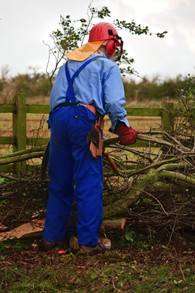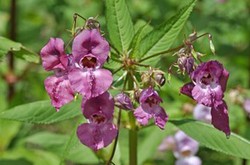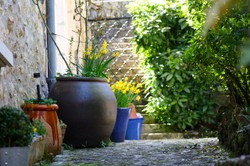If you go to the South West of England, the counties of Devon and Cornwall, you will notice that the lanes are quite sunken in many places and the hedges grow on high banks. The banks seem to be the bulk of the field boundary, and sometimes the banks are stone faced. The hedge on top tends to be small. This style of hedge is found also in other south western areas, including parts of Pembrokeshire, Wales' most South Western county, and scholars think that it might be a very ancient style that has survived to shape the landscape. In northern parts of the country, the stony hills of the Pennines and Cumbria [where the Lake District is situated] hedges tend to be few as dry stone walls are the norm. But across most of England hedges are common and they shape the patchwork of fields that give the English landscape its distinct character.
Scholars can confidently assert that some hedges are really ancient, possibly going back beyond the dawn of recorded history. One way of telling such hedges is that they grow on top of low banks, and it is thought that these hedges used to surround woodlands that were hedged against marauding deer. The woods are often gone, changed into fields, but the hedge remains as a relic of an ancient pedigree. Sometimes such ancient hedges were simply carved from the ancient wood and allowed to grow.When this happened people took the scrub at the edge of the wood and managed it into a hedge. One of the signs of hedges like this is that they contain wild, woodland flowers, such as anemones and bluebells. Some such derelict hedges appear in the landscape as lines of mature trees. What happened here is that the hedge was of a kind known as hedge with standard trees. Parkland owners or farmers cut down the hedge but left the trees, so you can trace the line of the hedge though it is gone.
One of the criteria by which the age of a hedge can be determined to a rough degree is the straightness or otherwise of it. Mediaeval hedges reflect the state of England at that period, a hotch potch of fields without clear pattern. The ancient hedges from this period are often curved, sometimes tracing an S pattern, sometimes a c along the winding English lanes, themselves ancient routes. In these ancient hedges there is a wide variety of species, often reflecting local woodland conditions, for people often went into the woods to dig up the plants for the hedge. Later hedges from the period of enclosures, the late eighteenth century, are often in ruthlessly straight lines reflecting modernist rationalism and contain either entirely hawthorn,or a mixture of hawthorn and blackthorn, a spiky plant well suited for hedging. Some earlier attempts at hedges formed of barberry [Berberis] foundered, for despite its savage spikes well capable of deterring intruders, it hosts a fungus inimical to wheat, so many barberry hedges were grubbed up to be replaced by hawthorn.
A more recent type of hedge has grown up besides walled fields, where the all has been lined by untrimmed vegetation. This is more common in Northern England, where stone walls are the norm.
If some of you wonder why I have not discussed Hooper's Rule, which attempts to assess the age of a hedge by counting the number of species in it, my refraining is because there is criticism of this rule, and even Hooper thought it at best a rule of thumb, so I believe that it misleads and should be abandoned.











 Pilgrimage. A reviewon 06/15/2025
Pilgrimage. A reviewon 06/15/2025
 Leo the Fourteenthon 05/09/2025
Leo the Fourteenthon 05/09/2025
 The Melsonby Hoardon 03/25/2025
The Melsonby Hoardon 03/25/2025



Comments
No physical descriptions are given in the New Testament. So no.
Thank you for your comment below in answer to my previous observation and question.
The eye colors of the Holy Family members intrigue me.
Is there any tradition about St. Joseph's eye color?
Mary, as a saint might appear in a variety of human forms consistent with her identity..she will always be feminine..
Thank you for your comment below in answer to my previous, same-day observation and question.
It interests me that western and Indian Christians respectively make Our Lady Mary blue- and dark-eyed.
There might be a reconciliation so that both depictions operate as true.
Would it be possible for Our Lady Mary as hazel-eyed and therefore blue-, dark-, green-eyed in different biogeographies?
No, but blue and green eyes were rare among Middle Eastern folk. But no one saw fit to make records of such matters. Mary's are depicted as blue, in the west, but Indian Christians depict her as Indian with Brown skin and dark eyes. Most people in the human race are brown so I think that Mary was probably light brown. Jesus also.
The Catholic Faith Store online advises us to "Get out and pray: how to create a prayer garden."
For Mary-dedicated prayer gardens, the aforementioned site considers:
Lilies, for Mary's grace and purity;
Roses, for Mary's heavenly queenship;
Stars of Bethlehem, for the Magi;
Violets, for Mary's modesty and simplicity;
Carnations, for blooming the night of Jesus' birth;
Forget-Me-Knots, for Mary's radiantly blue eyes.
Is it traditional to imagine Our Lady Mary as blue-eyed?
Is there any tradition about Jesus Christ's and St. Joseph's eye colors?
True.what matters in prayer is that it be performed in the right spirit.
Be Thou my vision does fit with night-time prayer, especially with the line "both waking and sleeping, Thy presence my light."
But I give myself permission for important day prayers because of the preceding line "be Thou my best thought in the day and the night."
Prayers inspire us in a great variety of ways. Be thou my vision is for me a night time prayer.
Amen.
Nathan Pacheco concludes Be Thou my vision with "Amen" seven times. I like to link that septet with the seven days of Creation, from which God remains always there for us, morning though afternoon through evening through night, and over and over again.